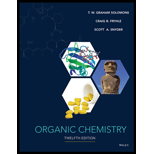
Interpretation:
The radical mechanism for the given reaction is to be represented.
Concept introduction:
Electrophiles are electron-deficient species, which has positive or partially positive charge. Lewis acids are electrophiles, which accept electron pair.
Nucleophiles are electron-rich species, which has negative or partially negative charge. Lewis bases are nucleophiles, which donate electron pair.
Radical is an atom or molecule that has an unpaired valence electron. These unpaired electrons makes radical highly chemically reactive.
Substitution reaction: A reaction in which one of the hydrogen atoms of a hydrocarbon or a
Elimination reaction: A reaction in which two substituent groups are detached and a double bond is formed is called elimination reaction.
Addition reaction: It is the reaction in which unsaturated bonds are converted to saturated molecules by the addition of molecules.
Reduction is a process in which hydrogen atoms are added to a compound.
Homolytic fission is that fission in which each atom in the bond has an electron, which results in species called free radical.
In heterolytic fission, when covalent bond is broken, the shared pair of electron is taken by one of the atoms.
A type of halogenation in which
Want to see the full answer?
Check out a sample textbook solution
Chapter 10 Solutions
ORGANIC CHEM. VOL.1+2-W/WILEYPLUS
- the following reaction scheme leads to the formation of compound B. give the structure of the final products and of the intermediate product A and justify, using the mechanism, the formation of thesearrow_forwardPlease provide the mechanism and reagents for this reactionarrow_forwardExplain why free-radical halogenation usually gives mixture of products.arrow_forward
- what is the mechanism for this reaction and would be the structure of the product?arrow_forwardplease help with this ochem reaction scheme provide the bond line structures for the compound formed at step A and B of the attached reaction scheme.arrow_forwarda) Write the name of three steps of free-radical halogenation of methane?b) Give the mechanism of formation of dichloromethane from chloromethane?c) Explain why free-radical halogenation usually gives mixture of products.arrow_forward
- Substitutions on aromatic rings are generally carried out by electrophilic substitution, but for the synthesis of phenolic compounds and alkoxy benzene it is carried out by nucleophilic substitution, explain why this is so .arrow_forwardWrite the mechanism and predict the product for the reaction of cyclohexene with bromine. Make sure that you include the stereochemistry for the reaction in your mechanism. Then describe in detail the appearance of the reactants and products in this reaction. What would be the visible evidence that a reaction took place? Explain paragraph why no color change would occur upon mixing cyclohexanol with a solution of bromine.arrow_forwardThe Friedel-Crafts Alkylation of p-xylene n-propyl bromide can result in an isopropyl as well as n-propyl substitution. A) Write the chemical equation involved in this reaction. B) Which will be the major and minor product? What do you expect will be the ratio of n-propyl to isopropyl substitution for p-xylene?arrow_forward
- The homolysis of the OO bond in diacetyl peroxide gives two acetyl radicals with the Lewis structure The formal charge on this radical is .arrow_forwardThe addition of water to aldehydes and ketones occurs rapidly, although it is not thermodynamically favored. What would be the product for the reaction above? Hint: Think of the self-ionization of water and the polarity of the carbonyl group.arrow_forwardExplain and describe details for this mechanism.arrow_forward

 Chemistry for Today: General, Organic, and Bioche...ChemistryISBN:9781305960060Author:Spencer L. Seager, Michael R. Slabaugh, Maren S. HansenPublisher:Cengage Learning
Chemistry for Today: General, Organic, and Bioche...ChemistryISBN:9781305960060Author:Spencer L. Seager, Michael R. Slabaugh, Maren S. HansenPublisher:Cengage Learning
 Organic ChemistryChemistryISBN:9781305580350Author:William H. Brown, Brent L. Iverson, Eric Anslyn, Christopher S. FootePublisher:Cengage Learning
Organic ChemistryChemistryISBN:9781305580350Author:William H. Brown, Brent L. Iverson, Eric Anslyn, Christopher S. FootePublisher:Cengage Learning



